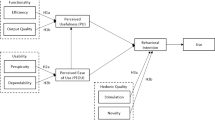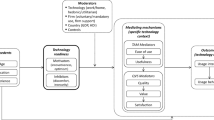Abstract
Technological innovation is seen as the key to survival and success for many firms. Whether intended for internal use or for customers, adoption decisions must consider the response of the final user to such technological alternatives. This paper argues for greater attention to the factors which cause individual resistance to technological innovations. The results of two studies are reported which examined the effects of self-efficacy (Bandura 1977) and performance satisfaction on consumers’ response to technological changes. Results indicate that a person’s perceived ability to use a product successfully affects their evaluative and behavioral response to the product. In addition, the level of satisfaction experienced with an existing behavior increases resistance to and reduces likelihood of adopting an alternative.
Similar content being viewed by others
References
Ajzen, Icek. 1985. “From Intentions to Actions: A Theory of Planned Behavior.” InAction Control: From Cognition to Behavior, pp. 11–39. Eds. Julius Kuhl and Jurgen Beckman. Berlin, Germany: Springer-Verlog.
Ajzen, Icek and Martin Fishbein. 1980.Understanding Attitudes and Predicting Social Behavior. Englewood Cliffs, NJ: Prentice-Hall.
Bandura, Albert. 1986. “The Explanatory and Predictive Scope of Self-Efficacy Theory,”Journal of Social and Clinical Psychology 4 (3): 249–255.
—. 1977. “Self-Efficacy: Toward a Unifying Theory of Behavioral Change.”Psychological Review 84: 191–215.
Beals, Ralph L. 1968. “Resistance and Adaptation to Technological Change: Some Anthropological Views.”Human Factors 10 (6): 579–588.
Blackler, Frank and Colin Brown. 1985. “Evaluation and the Impact of Information Technologies on People in Organizations.”Human Relations 38 (3): 213–231.
Brod, Craig. 1982. “Managing Technostress: Optimizing the Use of Computer Technology.”Personnel Journal 61 (October): 753–757.
Byrnes, Elizabeth and James H. Johnson. 1981. “Change Technology and the Implementation of Automation in Mental Health Care Settings.”Psychonomic Science 13 (4): 573–580.
Calantone, Roger J., C. A. diBenedetto, and Michael H. Morris. 1985. “Technological Innovation: An Emerging Paradigm.” InAMA Educators’ Proceedings 51: 324–329. Eds. R. F. Lusch, G. L. Ford, R. D. Howell, C. A. Ingene, M. Reilly and R. W. Stampfl. Chicago, IL: American Marketing Association.
Carlsmith, J. Merrill, Phoebe C. Ellsworth and Elliot Aronson. 1976.Methods of Research in Social Psychology. Reading, MA: Addison-Wesley.
Cervone, Daniel, and Philip K. Peake. 1986. “Anchoring, Efficacy, and Action: The Influence of Judgmental Heuristics on Self-Efficacy Judgments and Behavior.”Journal of Personality and Social Psychology 50 (3): 492–501.
Coch, Lester and John R. P. French, Jr. 1948. “Overcoming Resistance to Change.”Human Relations 1 (4): 512–532.
Cohen, J. 1977.Statistical Power Analysis for the Behavioral Sciences. New York: Academic Press.
Danko, William O. and James M. MacLachlan. 1983. “Research to Accelerate the Diffusion of a New Invention.”Journal of Advertising Research 23 (June–July): 39–43.
Davis, Fred D., Richard P. Bagozzi, and Paul R. Warshaw. 1989. “User Acceptance of Computer Technology: A Comparison of Two Theoretical Models.”Management Science 35 (August): 982–1003.
Dickerson, Mary Dee and James W. Gentry. 1983. “Characteristics of Adopters and Non-Adopters of Home Computers.”Journal of Consumer Research 10 (September): 225–235.
Frantzich, Stephen E. 1979. “Technological Innovation Among Congressmen.”Social Forces 57 (March): 968–974.
Gatignon, Hubert and Thomas S. Robertson. 1985. “A Propositional Inventory for New Diffusion Research.”Journal of Consumer Research 11 (March): 35–49.
Gatignon, Hubert and Thomas S. Robertson. 1989. “Technology Diffusion: An Empirical Test of Competitive Effects.”Journal of Marketing 53 (January): 35–49.
Gold, Bela. 1981. “Technological Diffusion in Industry: Research Needs and Shortcomings.”The Journal of Industrial Economics 29 (3): 247–269.
Goldstein, Jeffrey. 1988. “A Far-from-Equilibrium Systems Approach to Resistance to Change.”Organizational Dynamics 17 (2): 16–26.
Hill, Thomas, Nancy D. Smith, and Millard Mann. 1985a. “Communicating Innovations Convincing Computer Phobics to Adopt Innovative Techniques.” InAdvances in Consumer Research 13: 419–422. Ed. Richard Lutz. Provo, UT: Association for Consumer Research.
Hill, Thomas, Nancy D. Smith, Millard Mann, and Bruce F. Roberson. 1985b. “Efficacy Expectations and Technology Adoption: The Case of Computers.” InProceedings of the Division of Consumer Psychology (Division 23), pp. 15–19. Washington, D.C.: American Psychological Association.
Hiltz, Starr Roxanne and Kenneth Johnson. 1990. “User Satisfaction with Computer-Mediated Communication Systems.”Management Science 36 (6): 739–764.
Kelman, Herbert C. and Donald P. Warwick. 1973. “Bridging Micro and Macro Approaches to Social Change: A Social Psychological Perspective.” InProcesses and Phenomena of Social Change, pp. 13–59. Ed. Gerald Zaltman. New York: John Wiley and Sons.
Kirsch, Irving. 1986. “Early Research on Self-Efficacy: What We Already Know Without Knowing We Knew.”Journal of Clinical and Social Psychology 4 (3): 319–358.
Leonard-Barton, Dorothy, and William A. Kraus. 1985. “Implementing New Technology.”Harvard Business Review 63 (November–December): 102–110.
Maddux, James E., and R. W. Rogers. 1983. “Protection Motivation and Self-Efficacy: A Revised Theory of Fear Appeals and Attitude Change.”Journal of Experimental Social Psychology 19: 469–479.
Maddux, James E., Larry W. Norton and Cal D. Stoltenberg. 1986. “Self-Efficacy Expectancy, Outcome Expectancy and Outcome Value: Relative Effects on Behavioral Intentions.”Journal of Personality and Social Psychology 51 (4): 783–789.
Markus, M. Lynne and Daniel Robey. 1983. “The Organizational Validity of Management Information Systems.”Human Relations 36 (3): 203–226.
Midgely, David F. and Grahame R. Dowling. 1978. “Innovativeness: The Concept and Its Measurement.”Journal of Consumer Research 4 (March): 229–242.
Murdock, Gene W. and Lori Franz. 1983. “Habit and Perceived Risk as Factors in the Resistance to Use of ATMs.”Journal of Retail Banking 5 (2): 20–29.
Nadler, David A. 1981. “Managing Organizational Change: An Integrative Perspective.”The Journal of Applied Behavioral Science 17 (2): 191–221.
O’Connor, Edward, Charles Parsons, Robert Liden and David Herold. 1990. “Implementing New Technology: Management Issues and Opportunities.”The Journal of High Technology Management Research 1 (1): 68–89.
Perdue, Barbara and John O. Summers. 1986. “Checking the Success of Manipulations in Marketing Experiments.”Journal of Marketing Research 22 (November): 317–326.
Peterson, Robert A., Gerald Albaum, and Richard F. Beltramini. 1985. “A Meta-Analysis of Effect Sizes in Consumer Behavior Experiments.”Journal of Consumer Research 12 (June): 97–103.
Raju, P. S. 1980. “Optimum Stimulation Level: Its Relationship to Personality, Demographics, and Exploratory Behavior.”Journal of Consumer Research 7 (December): 272–282.
Ram, S. 1987. “A Model of Innovation Resistance.”Advances in Consumer Research 14: 208–212. Eds. Melanie Wallendorf and Paul Anderson, Provo, UT: Association for Consumer Research.
— 1989. “Successful Innovation Using Strategies to Reduce Consumer Resistance: An Empirical Test.”Journal of Product Innovation Management 6: 20–34.
Rogers, Everett M. 1983.Diffusion of Innovations. New York: McMillan Publishers.
Salerno, Lynn M. 1985. “What Happened to the Computer Revolution?”Harvard Business Review (November–December): 129–138.
Schein, Edgar H. 1985.Organizational Culture and Leadership. San Francisco: Jossey-Bass.
Seltzer, Leon F. 1983. “Influencing the ‘Shape’ of Resistance: An Experimental Exploration of Paradoxical Directives and Psychological Reactance.”Basic and Applied Social Psychology 4 (1): 47–71.
Sheth, Jagdish N. 1981. “Psychology of Innovation Resistance: The Less Developed Concept (LDC) in Diffusion Research.” InResearch in Marketing, pp. 273–282. Greenwich, CT: JAI Press.
Sheth, Jagdish N. and Gary L. Frazier. 1982. “A Model of Strategy Mix for Planned Social Change.”Journal of Marketing 46 (Winter): 15–26.
Taylor, Thayer C. 1987. “Computers in Sales and Marketing: S&MM’s Survey Results.”Sales and Marketing Management 138 (May): 52–53.
Thompson, Thomas W. 1984. “Slow Down, Fit It Together... and Let People Catch Up.”United States Banker (December): 56–57.
Watson, Goodwin. 1971. “Resistance to Change.”American Behavioral Scientist 4 (May–June): 745–766.
Zaltman, Gerald and Robert Duncan. 1977.Strategies for Planned Change. New York: John Wiley and Sons.
Zaltman, Gerald, R. Duncan, and J. Holbeck. 1973.Innovations and Organizations. New York: John Wiley and Sons.
Zuboff, Shoshana. 1982. “New Worlds of Computer-Mediated Work.”Harvard Business Review 60 (September–October): 142–152.
Author information
Authors and Affiliations
Rights and permissions
About this article
Cite this article
Ellen, P.S., Bearden, W.O. & Sharma, S. Resistance to technological innovations: An examination of the role of self-efficacy and performance satisfaction. JAMS 19, 297–307 (1991). https://doi.org/10.1007/BF02726504
Issue Date:
DOI: https://doi.org/10.1007/BF02726504




